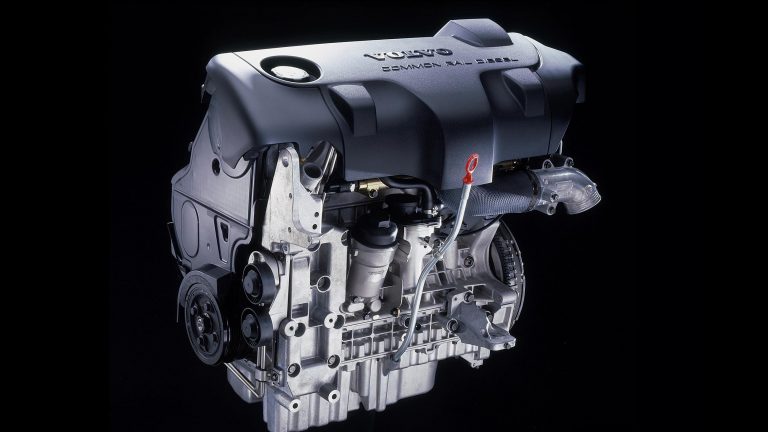[su_image_carousel source=”media: 52270,52271,52272,52273″]
Introduction
The Volvo Engine Diesel 5 (VED5) Gen 1 engine – hereafter, VED5 Gen 1 – was a 2401 cc five-cylinder turbo diesel engine that commenced production at Volvo’s Skövde engine plant in 2001. As per the table below, Volvo offered the VED5 Gen 1 engine under the D5244T and D5244T2 engine codes. Key properties of the VED5 Gen 1 engine included its:
- Five-cylinder, open-deck block made from die-cast aluminium with 81.0 mm bores and 93.2 mm stroke for a capacity of 2401 cc;
- Cast iron integral cylinder liners;
- Aluminium alloy cylinder head;
- Single cam belt-drive system for the camshafts and injection pump;
- Four valves per cylinder actuated by roller finger followers;
- Variable Nozzle Turbine (VNT) turbocharger;
- Bosch second-generation common-rail injection system (the first series-produced diesel engine to do so). The solenoid-controlled, five-hole injectors operated at a pressure of up to 1600 bar;
- Compression ratio of 18.0:1;
- Electronically-controlled, cooled Exhaust Gas Recirculation (EGR);
- Oxidising catalytic converter;
- Mass of 185 kg; and,
- 20,000 kilometre service intervals.
Upon its release, the VED5 Gen 1 engine complied with Euro 3 emissions standards.
In 2005, the VED5 Gen 1 was replaced by the VED5 Gen 2 engine.
[su_table responsive=”yes”]
| Code | Engine | Power | Torque |
|---|---|---|---|
| D5244T | 2401 cc turbo diesel I5 | 120 kW at 4000 rpm | 340 Nm at 1750-2750 rpm |
| D5244T2 | 2401 cc turbo diesel I5 | 96 kW at 4000 rpm | 280 Nm at 1750-3000 rpm |
[/su_table]
Development
Development of Volvo’s VED5 engine commenced in late 1997 as part of the ‘Neon project’. Given funding constraints, the engine had to be manufactured at Volvo’s Skövde engine plant and utilise Volvo’s existing modular engine architecture for its transversely mounted engines. The final decision to commence production of the diesel engine was taken by Volvo Cars Board in December 1998, two months before Ford Motor Company acquired Volvo Car Corporation.
For production of the VED5 engine,
- A new assembly system for diesel engines was created at Skövde;
- A new production system for cylinder heads was developed at the ‘daughter’ plant in Floby (around fifty kilometres from Skövde);
- The production line was adapted for the manufacture of connecting rods for the diesel engine; and,
- Where possible, existing production equipment for petrol engines was modified so that it could be used for diesel engines.
As at 2002, the Skövde plant had an annual capacity of 400,000 engines, of which there was capacity to produce 50,000 diesel engines per year.
Variable Nozzle Turbine (VNT) turbocharger
The VED5 Gen 1 engine had a VNT (Variable Nozzle Turbine) turbocharger. As such, the turbine on the intake side had movable guide vanes that changed position to provide optimum flow conditions and a high turbine efficiency rating throughout the engine speed range. This enabled high boost pressure from low engine speeds for a flatter torque curve and higher power output. The movable guide vanes were controlled by the engine management system, adjusting gas flow to the turbine to improve efficiency. Furthermore, the turbocharger was cooled by the engine oil.
Common-rail injection
The common-rail system adopted in the Volvo VED5 Gen 1 engine was a second-generation system with load-responsive volume and pressure control. The amount of fuel and injection timing were controlled electronically by fast-acting solenoid valves. Fuel was injected directly into the cylinders under high pressure (up to 1600 bar) for finely atomised fuel – this reduced the emissions of nitrogen oxides (NOx) and particulates.
Exhaust gas recirculation
To reduce emissions, the VED5 Gen 1 engine utilised Exhaust Gas Recirculation (EGR). With EGR, some of the exhaust gases were cooled in a special EGR cooler before being mixed with the intake air and then returned to the combustion system and the EGR valve was electrically operated. According to Volvo, the EGR cooler reduced nitrogen oxide (NOx) emissions by 7 per cent relative to a system without cooling.



